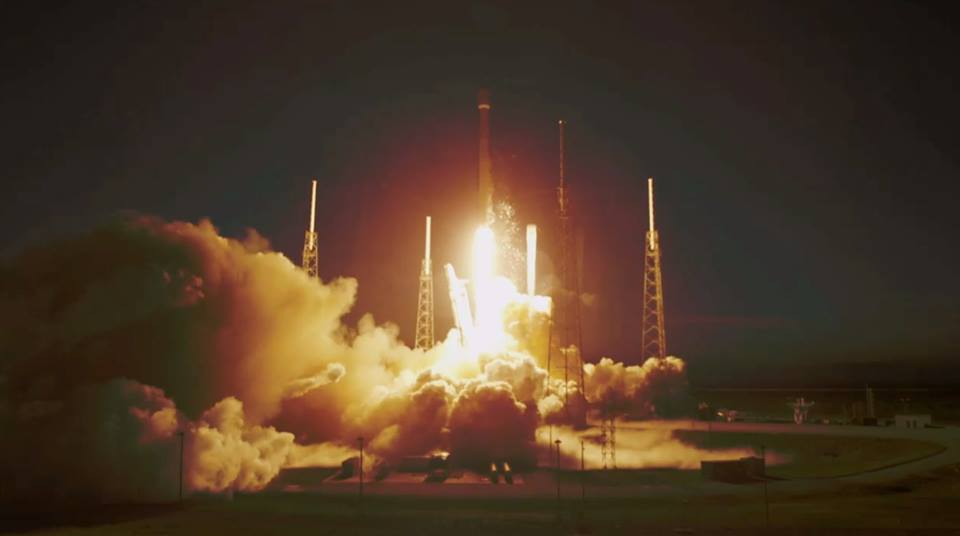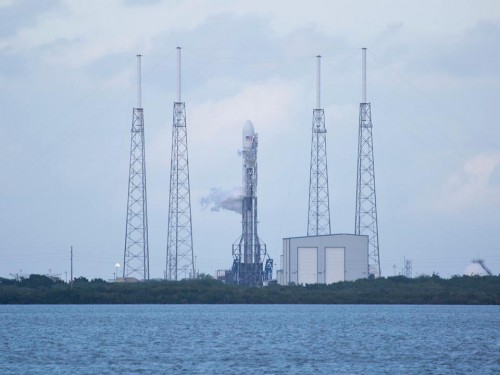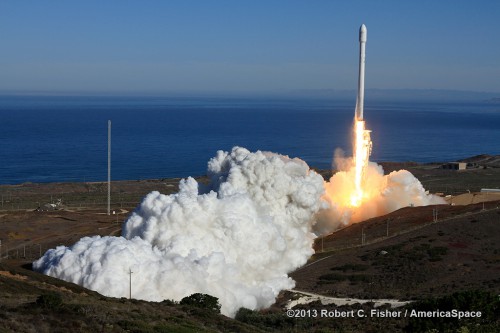
After two false starts, it was third time lucky for SpaceX—the Hawthorne, Calif.-based launch services organization, headed by entrepreneur Elon Musk—as the second Falcon 9 v1.1 rocketed aloft from Space Launch Complex (SLC)-40 at Cape Canaveral Air Force Station, precisely on time at 5:41 p.m. EST Tuesday. Powered by nine uprated Merlin-1D engines on its first stage and a single Merlin-1D Vacuum engine on its second stage, the Falcon successfully lofted the SES-8 communications satellite and at the time of writing was midway through its first mission to geostationary transfer orbit. In accomplishing this remarkable achievement, SpaceX has further cemented its credentials as a key player in the commercial launch services market.
This mission has been a long time coming. On Monday, 25 November, the opening launch attempt was halted at T-13 minutes, due to a technical issue with a first-stage liquid oxygen vent valve, prompting SpaceX to recycle the clock for a revised T-0 later in the 66-minute “window” as engineers scrambled to formulate a troubleshooting plan. A second countdown ticked down to T-6 minutes and 11 seconds, just shy of Autosequence Start, when the clock stopped again, due to a problem with the transition to first-stage internal power. Barely enough time remained in the window for another recycle, but SpaceX marched toward yet another revised T-0 time, but was eventually thwarted by a first-stage issue which halted the clock at T-3 minutes and 40 seconds. From that point, insufficient time remained in Monday’s window to attempt another recycle and the launch was scrubbed.

If Monday’s attempt proved nail-biting, then the second effort to get the Falcon 9 v1.1 airborne on Thanksgiving evening—Thursday, 28 November—demonstrated nothing less than the myriad safety systems of the two-stage booster in action. This time, the countdown ran with near-perfection, and with a seemingly flawless vehicle and exceptional weather conditions at the Cape, the command was issued to ignite the nine Merlin-1D engines at T-3 seconds. Carefully monitored by the flight computers, it soon became apparent that the thrust build-up of the engines’ chamber pressures did not meet required levels and an automatic shutdown was called, after the ignition sequence had started. The roar of rocket exhaust quickly died. Although the countdown clock read T+2 seconds, the hold-down clamps had not yet been commanded to release the Falcon from the SLC-40 pad surface. “This demonstrated the value of SpaceX’s hold-before-release system,” noted SpaceX’s Falcon 9 Product Director John Insprukter earlier tonight (Tuesday).
Noting a “slower than expected thrust ramp” in a tweet shortly after the abort, Elon Musk explained that closer inspection revealed no major problems and announced that the countdown was being recycled for another launch attempt. However, the clock was held as engineers focused on resolving the issue, with consensus eventually reached to attempt a launch at the very end of Thursday’s window. SES World Skies, the operator of the SES-8 satellite, confirmed that it was prepared to support an extension of 20 minutes beyond the nominal closure of the window, and weather conditions remained near-perfect, but it was not to be. The clock resumed and ticked down to T-48 seconds, when a “Hold, Hold, Hold” call was made and the countdown stopped. It was by now untenable for the engineers to properly evaluate their data and exhibit full confidence in the vehicle, when balanced against the limits of a rapidly-diminishing launch window. Finally, the attempt was scrubbed.
“Thursday’s abort was caused by oxygen in the ground-side igniter fluid,” SpaceX explained. “Rocket engines are healthy, but cleaning turbopump gas generators will take another day. Earliest possible attempt is Monday evening.” However, hopes to fly on Monday, 2 December, also proved fruitless. “All known rocket anomalies have been resolved,” SpaceX reported, but stressed that “The team will spend another day rechecking to be sure. Currently targeting launch on Tuesday, with Wednesday as a backup day.” Air Force meteorologists had also issued a gloomy forecast for Monday, with a 60-percent likelihood of acceptable conditions. Launch on Tuesday was targeted to occur within a slightly longer 86-minute window, which opened at 5:41 p.m. EST, and, as per confirmation from the SES-8 customer, included an additional 20 minutes, thereby closing at 7:07 p.m.

As with the two previous attempts, tonight’s countdown proceeded with exceptional smoothness, tracking a liftoff just after local sunset. At T-13 minutes, all stations were polled and confirmed their state of readiness as “Go” to proceed with the Terminal Count at T-10 minutes. As planned, the Terminal Count got underway at 5:31 p.m., and shortly afterward the flight control system was enabled and the nine Merlin-1D engines on the first stage began a “chill-down” protocol as part of pre-launch conditioning. Autosequence Start occurred at T-6 minutes, with the rocket’s propellant tanks verified to be at the proper flight pressures, and the launch pad’s “strongback” was completely retracted by T-4 minutes. The Flight Termination System (FTS)—tasked with destroying the Falcon in the event of a major accident during ascent—was placed onto internal power and armed, and by T-2 minutes and 15 seconds the first stage was confirmed to be at pressure.
“Range Green” came the call from Air Force Range personnel. At T-1 minute, the flight computer was confirmed to be in control of the vehicle, with the second-stage tanks pressing to flight pressures. SLC-40’s “Niagara” deluge system began to flood the pad surface with 30,000 gallons (113,500 liters) of water per minute to suppress acoustic waves radiating from the Merlin-1D exhaust plumes. At T-45 seconds, all tanks were confirmed to be at flight pressure. The vehicle’s propellant tanks were pressurized and at T-3 seconds the nine Merlin-1D engines roared perfectly to life. Unlike Thursday’s abort, all nine ramped up perfectly to their required parameters, and at 5:41 p.m. EST the second mission of the Falcon 9 v1.1 officially got underway with a spectacular roar.
At the instant of liftoff, the nine first-stage engines generated 1.3 million pounds (590,000 kg) of thrust, about 200,000 pounds (90,000 kg) greater than the Falcon 9 v1.0, and pushed the vehicle uphill for 180 seconds. Their propulsive yield gradually rose to 1.5 million pounds (680,000 kg) in the rarefied high atmosphere. “Unlike airplanes, a rocket’s thrust actually increases with altitude,” noted SpaceX. “Falcon 9 generates 1.3 million pounds of thrust at sea level, but gets up to 1.5 million pounds of thrust in the vacuum of space. The first-stage engines are gradually throttled near the end of first-stage flight to limit launch vehicle acceleration as the rocket’s mass decelerates with the burning of fuel.”
With around 1,970 seconds of test time and a lengthy qualification program, SpaceX has expressed supreme confidence in the Merlin-1D. During a full-duration-mission firing in June 2012 in McGregor, Texas, the engine operated at or above the power (147,000 pounds of thrust) and duration (185 seconds) required for a Falcon 9 launch. The Merlin-1D has a vacuum thrust-to-weight ratio in excess of 150:1, making it the most efficient liquid-fueled rocket engine in history. The ignition system for the v1.1’s first stage was tested in April 2013. The stage also includes four extendible landing legs, manufactured from carbon-fiber and aluminum honeycomb, to support a series of tests which SpaceX CEO Elon Musk hopes will lead to vertical-takeoff-vertical-landing (VTVL) capability by the latter half of the present decade.
Immediately after clearing the SLC-40 tower, the Falcon 9 v1.1 executed a combined pitch, roll, and yaw program maneuver to establish itself onto the proper flight azimuth for the injection of the SES-8 communications satellite into geostationary transfer orbit. Eighty seconds into the ascent, the vehicle passed Mach 1 and experienced a period of maximum aerodynamic stress (known as “Max Q”) on its airframe. The Merlin-1Ds continued to burn hot and hard, finally shutting down at T+2 minutes and 58 seconds, and the first stage was jettisoned five seconds later. The turn then came for two “burns” by the Falcon’s restartable second stage, which ignited for the first time at T+3 minutes and 10 seconds. Its single Merlin-1D Vacuum engine, with a maximum thrust of 180,000 pounds (81,600 kg), burned for 320 seconds to establish the vehicle and SES-8 payload into a “parking” orbit.

A minute into the second-stage flight, the two-piece Payload Fairing (PLF)—a 43-foot-long (13.1-meter) protective cover which encapsulated the SES-8 satellite—separated from the vehicle. “Like the inter-stage between the first and second stages,” explained AmericaSpace’s Launch Tracker in its notes for the inaugural Falcon 9 v1.1 launch on 29 September, “a pneumatic system is used to separate the two halves, rather than the traditional pyrotechnics.” Fabricated from carbon-fiber and aluminum-honeycomb, the PLF was extensively tested by SpaceX in April 2013 within the confines of the Reverberant Acoustic Test Facility at NASA’s Plum Brook Station in Sandusky, Ohio, part of the Cleveland-based Glenn Research Center.
The first shutdown of the second stage engine occurred at T+8 minutes and 30 seconds, after which the vehicle coasted for 18 minutes, ahead of a second “burn” to carry SES-8 into geostationary transfer orbit. “Reached parking orbit,” Elon Musk tweeted during this period of coasting. “Now coasting towards equator, where the upper stage will, if all goes well, restart to raise apogee.” The critical second burn, lasting about 71 seconds, got underway at approximately 6:08 p.m. EST, producing a clipped tweet from SpaceX: “Falcon 9 second stage restart burn successful. Orbit looks nominal.” And five minutes after the Merlin-1D Vacuum engine was due to shut down for the second time, at 32 minutes and 53 seconds after liftoff, the satellite was expected to be released into its 180 x 50,000-mile (300 x 80,000 km), 20.75-degree-inclination transfer orbit. This process was to be monitored closely, for SpaceX was unsuccessful in restarting the Merlin-1D Vacuum during the 29 September maiden flight of the Falcon 9 v1.1. A propulsive-return-over-water test was not planned to occur on the SES-8 flight, or on the planned 20 December launch of the Thaicom-6 communications satellite, but will be attempted on the February 2014 flight of the third dedicated Dragon mission (SpX-3) to the International Space Station.
The SES-8 mission is a pivotal one for SpaceX. Whereas the CASSIOPE spacecraft was inserted into a polar orbit with an apogee of 920 miles (1,480 km), tonight’s planned flight of the Falcon 9 v1.1 has been described by the company as its “First GEO Transfer Mission,” delivering SES-8 into a geostationary transfer orbit, whose apogee of 50,000 miles (80,000 km) is one-quarter of the distance to the Moon. SES-8 has been built by Orbital Sciences Corp. and will ultimately be co-located with the 2002-launched NSS-6 communications satellite at 95 degrees East longitude. Its primary purpose is to utilize its high-performance beams to support bandwidth-growth capability in the Asia-Pacific region, with specific focus upon emerging markets in South Asia and Indochina. Equipped with 33 Ku-band and Ka-band transponders, SES-8 will also provide expansion capacity for direct-to-home, very-small-aperture terminals and government applications. Operated by Dutch-based operator SES World Skies, it should remain operational for about 15 years.
Want to keep up-to-date with all things space? Be sure to “Like” AmericaSpace on Facebook and follow us on Twitter: @AmericaSpace
Missions » Commercial Space » SES » SES-8 »




YAY!!! WE DID IT!!!
Was there any further accomplishements toward reusability by the launch?…Anyone…
No, this launch and the upcoming Thaicom launch both require all the thrust of the first stage. They’ll get back to first stage recovery testing with CRS-3 next year.
http://youtu.be/muWftxDkl8g, When the first stages come back, i’m going to need Two Telescopes!!
Tracy, as noted in the article, the next attempt to do a propulsive return over water will be made on the SpX-3 Dragon launch in February 2014.
Ben,
Did the first stage in fact include legs that were not deployed per the article below…
” The ignition system for the v1.1′s first stage was tested in April 2013. The stage also includes four extendible landing legs, manufactured from carbon-fiber and aluminum honeycomb, to support a series of tests which SpaceX CEO Elon Musk hopes will lead to vertical-takeoff-vertical-landing (VTVL) capability by the latter half of the present decade.”
Third Time Lucky for SpaceX as Falcon 9 Completes First GEO Transfer Mission « AmericaSpace girls north face jackets xl north face womens jackets size xxl http://www.couponmom.com/couponmom/index.php?module=content&brand=the-north-face&pid=1385632800